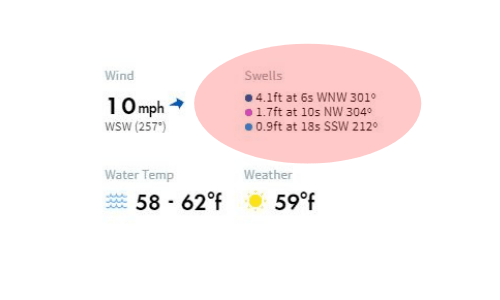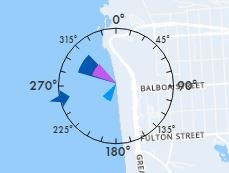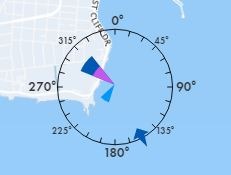How to Read a Surf Report
Wes Severson September 23rd, 2020 Posted In: How-To Tags: Surfing
How to Read a Surf Report
Get a good idea of what to expect before you head to the waves
If you’ve ever looked at your local surf report your first reaction may have been “wow that is a lot of numbers!” Not to worry though! It’s not that hard to understand and once you do you will be well on your way to scoring better surf sessions.
Where to Start
There are several websites and online services that give very detailed information on the swells in your area and all over the world. They all mostly display the same type of readings but others are much more robust than others. For instance, the most popular is Surfline which has a network of hundreds of HD cameras along with the basic swell information. They also have professional surf forecasters who have eyes on the surf and can help you determine what the waves will be all about that day.
However, the cameras and the forecasters will only help on the day you want to go. If you want to try to predict what the waves will be like later then you have to go to the numbers which will require you to learn how to read a surf report. I will be using readings from Surfline to walk you through it all.
 Swell Height
Swell Height
This is the first main reading you should pay attention to when learning how to read a surf report is the swell height. The height of the wave is measured by feet and is highlighted in pink. You can see that on this day in San Francisco the waves were coming in from 3 directions. The top is the biggest.
Don’t be deceived though, this number does not mean the actual size of the waves hitting the beach. These are the average size of the swells being read by that are passing under buoys that are miles away from the beach. There are a lot of factors that go into what makes the wave the size it is once it is ready to break.
Swell Period
The next number you see in the pink is time. The top line says 6 seconds. That means the swells are passing by the buoys every six seconds. That is fast. Fast means weak waves. If you look at the screenshot from the Surfline camera of those conditions you can see the waves are nowhere near 4 feet tall and the conditions look weak and awful. That is a result of fast-moving swells.
On the other hand, look at the bottom number. A 0.9-foot swell at 18s is actually a very long period swell which is good. That may mean that these smaller swells are turning into the waves that are closer to 3 feet tall and actually rideable.
So why does this happen? The fast wave loses speed very quickly once it runs into the sand creating a weak break. A long period swell hits the beach and then has a lot more energy behind it to build it up and make it break in a way that is fast and powerful which is what we generally want as a surfer. This YouTube video explains what happens in more depth.
 Swell Direction
Swell Direction
The next thing you need to consider when you are learning how to read a surf report is where the waves are coming from. We are talking about the specific direction the waves have to travel to hit the beach where you are surfing. You can see the direction of the waves inside that circle marked with degrees. You can see the biggest swells are coming in from the northwest at around 300-degrees. The southwest swell is coming in at around 215-degrees.
Ocean Beach in San Francisco faces west which means it catches most swells that have a westerly direction. That means the beach can be loaded with different sized waves that often appear to be random and scattered. Other California beaches like in Santa Cruz are facing south which means they get hit with any swells that are coming from the south and the north swells are totally blocked by land.
 Generally swells develop from weather thousands of miles away. Weather is more active in the northwest during winter which means the waves in San Francisco are better in that season. Santa Cruz is better in the summer because there is more weather activity brewing from the southwest.
Generally swells develop from weather thousands of miles away. Weather is more active in the northwest during winter which means the waves in San Francisco are better in that season. Santa Cruz is better in the summer because there is more weather activity brewing from the southwest.
Make sure you know which beaches in your area face which direction. Also, make sure to consider any islands or features that can be dozens, or even hundreds of miles away that can potentially block an incoming swell.
Wind
Reading the wind is a very important part of how to read a surf report. Wind can turn even the best waves into unrideable messes. The less wind there is at the beach the better. Winds are generally lighter along the coast in the morning which is why so many surfers wake up at dawn and hit the beach. If you can get to your favorite spot on a day with little to no wind you are going to get glassy, smooth conditions.
When you’re learning how to read a surf report it is also important to know the difference between onshore and offshore winds. Onshore winds blow from the ocean and onto the shore. These are the winds we don’t want. These create choppy conditions that produce unorganized conditions that are very hard to ride. You can see the winds today are coming from the west in SF which means they are Onshore in the first image above.
Offshore winds blow from land onto the beach and can be helpful in creating smooth conditions. They can also help create a better shape to the wave you are riding. The wind off the top of the waves is a tell-tale sign you have offshore winds.
Tides
The final part of the puzzle of how to read a surf report is understanding the tides. There are 2 low tides and two high tides every day and they shift every 5 hours or so. These tides are predictable and go off of the cycle of the moon but they can also be impacted by big weather systems. The tide shifts every day by about 50 minutes. So, if the low tide is at 6:30 am today, it will hit around 7:20 am tomorrow and then 8:10 am the following day.
As far as how the tide impacts the actual surf conditions is a different story. It varies tremendously from surf spot to surf spot. Some places are great at low tide and others are the best when it’s high tide. There are some areas that thrive in between tides. Some spots are only rideable during extreme low or high tides. Fort Point under the Golden Gate Bridge is only surfable during extremely low tide. The best way to figure out what works best at your favorite spot is to ask other surfers or try looking through online surf forums. Your local surf shop will also likely know when the best time to go will be at popular spots in the area.
Remember the Readings
Now that you know to read a surf report the next thing to do is start remembering what the readings were like on those really good days you surf. If you go out one day and the waves are really good, then read the report again and remember what made the conditions so good. That way, next time you see those same conditions you will know the waves will be very good at that one particular spot. Once you learn how to read a surf report make sure to keep doing it on a daily basis and are making your own predictions to see how they pan out. Like the weather, everything is just a forecast so it is very easy to get wrong and takes a lot of practice to consistently get it right.

